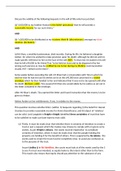Exam (elaborations)
Three certainties & Secret Trusts
- Module
- Equity and Trusts
- Institution
- University Of Reading (UoR)
This is a full problem question past year exam answer, focusing on the topic of three certainties and secret trusts, with lots of bonuses from different sources. I answered in the same way in my exam and I got a First Class grade. This essay can definitely help you in scoring, guaranteed.
[Show more]



